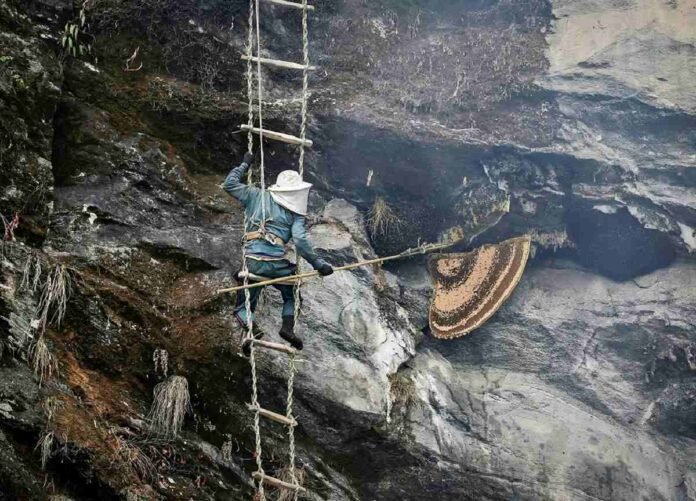15:58 JST, June 20, 2024
TAAP, Nepal (Reuters) – Aita Prasad Gurung dangled from a cliff in Nepal and carefully manipulated a long pole with a knife on the end to cut away chunks of honeycomb after Himalayan bees fled the fumes of a fire set to take them out of their to evict houses.
The 40-year-old wore a white hat with a net covering his face to protect against stings as he hung 50 meters above the abyss from a handmade ladder woven from bamboo strands to reach the bee colonies.
“There is a danger of falling,” said Aita, whose community traditionally harvests honey from beehives hundreds of meters above the ground. “You have to extract honey and stay safe at the same time.”
Now the age-old craft is increasingly under threat, as some experts say rising temperatures caused by climate change are disrupting the growth of bees, the availability of their food and even the pollination of plants.
“Last year there were about 35 beehives,” said another community member, Chitra Bahadur Gurung, 49. “We now have barely 15.”
For generations, the Gurung community in Taap, about 175 kilometers west of the capital Kathmandu, and other villages in the nearby Lamjung and Kaski districts, have scoured the steep Himalayan cliffs for honey.
Earlier, villagers took part in the ritual slaughter of a red rooster, parting its legs and feathers as an offering to the rock god, to ask forgiveness for taking the honey of the giant bees, known to scientists as Apis laboriosa.
The honeycomb extract, sometimes called “crazy honey” because of its intoxicating properties that can cause hallucinations, is sold for 2,000 Nepalese rupees ($1.5) per liter, but villagers rule out overfishing as a reason for declining collections.
The yields, shared among the group, are drying up as the number of beehives dwindles, the villagers said, although some make a living growing rice, corn, millet and wheat.
With less honey available to collect each year, hunting income has declined over the past decade, says 41-year-old Hem Raj Gurung.
“Ten years ago we harvested about 600 kilos of honey, which dropped to about 180 kilos last year and only about 100 kilos this year,” he said.
Some experts blame climate change, caused by a global temperature rise, as a major factor in the decline, but other contributing factors include deforestation, the diversion of water from streams and rivers for hydroelectric dams and the use of pesticides.
Temperatures in the Himalayas, home to the planet’s highest peaks, are exceeding an average global increase of 1.2 degrees Celsius above pre-industrial levels, United Nations data and independent research shows.
Global studies show that a temperature increase of even one degree affects the growth of bees, the availability of their food and the cross-pollination of plants, says Suruchi Bhadwal of the Indian Energy and Resources Institute (TERI).
Research showed that climate change was disrupting bee food chains and plant flowering, affecting populations around the world, added Bhadwal, head of earth sciences and climate change at the institute.
“In terms of the patterns and what we’re talking about, I think the patterns are the same in Nepal,” she said.
Climate change is impacting Himalayan cliff bees in several ways, says Surendra Raj Joshi, a resilient livelihoods specialist at the International Center for Integrated Mountain Development (ICIMOD) in Kathmandu.
“Too much or too little rain, intense or irregular rain, and long dry spells or wide temperature swings put pressure on honeybees to maintain colony strength and honey supplies,” he said.
Changes in plant life cycles also cause early or late flowering and fluctuations in nectar and honeydew secretion, he said, adding: “The most visible indicator of climate change is erratic weather.”
Some experts say floods and landslides can cause habitat loss and reduce the areas where bees can forage for food.



